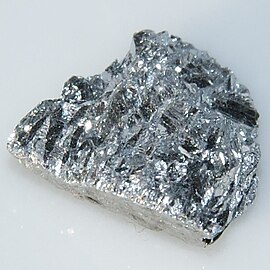Antimony
Antimony is a chemical element in the Periodic Table of Elements, which has the symbol Sb and proton number 51. It has been known since ancient times, it was first prepared by the Persian alchemist Geber. In Europe, its production was first described by Vannoccio Biringuccio in the book De la pyrotechnia in 1540. It is a polonium that is used (either as a pure element, alloy or in the form of compounds) in printing, metallurgy, electronics and medicine.
History of the name
Chemists are still not clear about where the name of the element comes from. The current name of the element comes from Greek. Antimony could thus be translated as one who is never alone (anti - monos). The ancient Greeks already noticed that it is not at all easy to find it alone in nature. Although it is rarely found in its pure form, it is mostly found in a mixture of metals, although also gold, but mainly lead and silver ores. The Low Tatras are also important deposits of ores containing antimony.
 |
Physical properties
Antimony has a metallic appearance, has a silvery color, is brittle, conducts electricity and heat poorly. Under normal conditions it is chemically stable, at elevated temperature it reacts with atmospheric oxygen to form antimony oxide. In addition to the metallic modification, there are also non-metallic modifications - black and yellow antimony. These are very unstable, when the temperature increases without air access, they change to a metallic form.
Antimony compounds
Hydrides and antimonides
In the −3 oxidation state, antimony forms compounds with hydrogen or less electronegative elements. The best known is stibane (antimonohydrogen - SbH3), a reactive poisonous gas (a theoretical analogue of ammonia). It is prepared by the reaction of antimony compounds with strong reducing agents containing a hydride anion (e.g. with lithium aluminum tetrahydride - LiAlH4) according to the reaction:
4 Sb2O3 + 6 LiAlH4 → 8 SbH3 + 3 Li2O + 3 Al2O3
4 SbCl3 + 3 NaBH4 → 4 SbH3 + 3 NaCl + 3 BCl3
Stibán is very unstable, even under normal conditions it breaks down into individual elements in the air, or reacts with oxygen
2 SbH3 → 3 H2 + 2 Sb
2 SbH3 + 3 O2 → Sb2O3 + 3 H2O
An analogue of hydrazine is distiban Sb2H4, where antimony appears in the −2 oxidation state. Of the other compounds, intermetallic alloys such as indium antimonide (InSb) or gallium indium arsenide antimonide phosphide (GaInPAsSb) are important, which are used as semiconductor materials in electronics.
